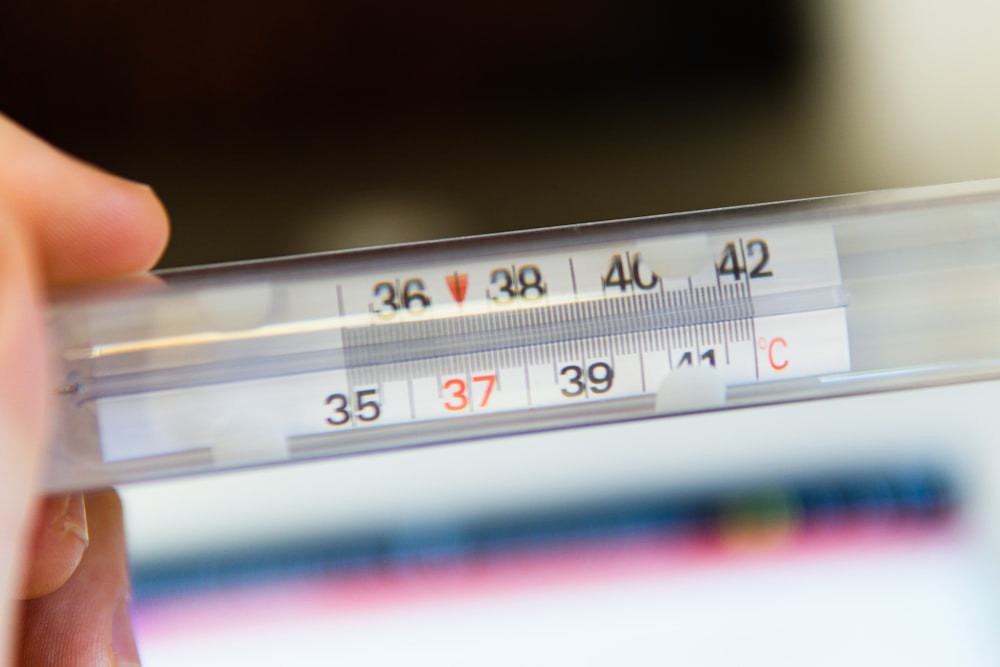Basal Body Temperature
What Is It?
The Basal Body Temperature Method, also known as the “Sympto-Thermal Method” is a complicated (but natural) method of contraception that is based on both the cervical secretions and body temperature of the female. Like all other natural methods of contraception, besides withdrawal, it requires the user to abstain from unprotected sex for a period of time in order to be effective. Ideally, one should visit a family planner and/or doctor before attempting this form of contraception. This is due to the unpredictable and fluctuating nature of menstruation and ovulation.
How To Use

Similar to the “Cervical Mucus Method,” unprotected sex is halted on the first day of cervical secretions. On each proceeding day, the user measures their body temperature. Since the body temperature spikes after ovulation, an observed increase in body temperature of around 0.4°F would signal that ovulation has occurred. Three days after the body temperature increase, the user can participate in intercourse again.
When Are You Fertile?
A woman is potentially fertile from the time cervical secretions begin up until three days after the spike in body temperature. While cervical mucus blocks sperm from passing through the cervix prior to ovulation, during the fertile phase the cervical mucus actually facilitates the sperm’s passage through the cervical canal by increasing sperm longevity. Women are usually the most fertile during the two to three days preceding the temperature spike.
Advantages of the Basal body Temperature Method
The Basal Body Temperature Method has similar advantages and disadvantages as the other natural methods of contraception.
- It is inexpensive, the only thing that may need to be purchased is a digital thermometer
- Since it is natural, it can be used by those who feel that “artificial” contraception is immoral
- It does not carry the risk of the health effects associated with hormone-based contraception
- There is no long-term effect on the ability to become pregnant, so its easily reversible
Disadvantages of the Basal body Temperature Method
The disadvantages of this method are also similar to the other natural methods of contraception.
- Not as reliable as other methods
- Requires abstinence and/or use of condoms
- Requires a high degree of attention; missing cervical secretions or forgetting to check body temperature could completely undermine the effectiveness of this method
- No protection from sexually transmitted infections (STIs)
Cost
This method costs little or nothing to the user. The only possible expenses are purchases of a digital thermometer (which can be found for as little as $5) and, if desired, condoms for the post-secretion time period.
Effectiveness
With perfect use, this method can have a 2% failure rate, which is the same as the Calendar method. Human error and natural fluctuations bring its actual failure rate to 15%.
Calendar Rhythm Method
What Is It?
The Calendar Rhythm Method is a natural form of contraception based on abstaining from sex (or using condoms) during the time that a female is likely to be fertile. The calendar method helps you estimate the time of ovulation (the release of the egg from the ovary) after you have charted the lengths of your menstrual cycles for several months.
How To Use the Calendar Method
- Keep track of the lengths of your menstrual cycles for 6-12 months. Day 1 is the first day of your menstrual bleeding.
- After six or twelve months of data collection, find the length of the shortest and longest menstrual cycle.
- Subtract 18 from the length of your shortest cycle. This tells you the first fertile day in your average cycle. For example, if your shortest cycle was 24 days long, then your first fertile day would be day 6 of your cycle.
- Subtract 11 from your longest cycle. This will be the last fertile day in your average cycle. For example, if your longest cycle was 32 days long, then your last fertile day would be day 21 of your cycle.
- During this fertile period (e.g., Day 6 through Day 21) you must abstain from having unprotected intercourse.
When Are You Fertile?

As described above- if your longest cycle was 32 days, and your shortest was 24, you would potentially be fertile from day 6 of your cycle through day 21 of your cycle. The length of potential fertility is greater as the distance between your longest and shortest menstrual cycles increases.
Advantages of the Calendar Method
This method has similar advantages and disadvantages as the other natural methods of contraception.
- It is completely free
- It is usable by women with highly variable menstrual cycles
- Since it is natural, women who oppose “artificial” forms of contraception can use it. In fact, at one point it was the only contraceptive technique supported by the Catholic Church.
- It does not carry the risk of health effects associated with hormone-based contraception
- There is no long-term effect on the ability to become pregnant
Disadvantages of the Calendar Method
The disadvantages of this method are similar to the other natural contraception methods, with some additional negative aspects included.
- It has a large window of potential fertility, eliminating the possibility of sex for a large portion of the month
- Not as reliable as other methods
- Requires abstinence and/or use of condoms
- Requires a high degree of attention. The user must be diligent in tracking the length of their menstrual cycles. Corrupt data would lead to corrupt fertility windows.
- It does not offer protection against sexually transmitted infections.
Cost?
This method is free to the user.
Effectiveness?
With perfect use, this method can have a 2% failure rate, . However, this is rarely the case. Estimates have placed the annual failure rate at anywhere from 13-24%. This high failure rate, along with its extensive demands on attention and sexuality, make it a rarely recommended and utilized form of birth control.
Cervical Mucus Method
What is the Cervical Mucus Method?
The cervical mucus method is a natural method of contraception based around the monitoring of fluid secreted by the cervix. The cervix is the lower part of the uterus that connects to the vagina, and has an opening for sperm to enter and menstrual fluid or cervical mucus to exit. The secretion of cervical mucus, a thick white discharge, is a possible indicator of fertility. There are two different ways of undertaking the cervical mucus method: the TwoDay method, and another method concerning the consistency of the mucus.
How to Use?
It can be very difficult to interpret changes in your cervical mucus. Ideally, you should take a class at a local family planning clinic that can teach you how to use this method accurately. It is also a good idea to abstain from unprotected intercourse (or other things that may alter your cervical secretions) for the first month that you use this method. That way you can accurately chart changes in your secretions. While cervical mucus can sometimes be observed as discharge on underwear or when using the restroom, the best way to observe whether or not mucus is being secreted is to insert a finger into the vagina and check for the mucus. You should try stretching the mucus secretions between your thumb and index finger to see how far they stretch. It is a good idea to keep track of changes in the consistency of your cervical mucus in a diary or on a special chart. You should take note of color, quantity, and slipperiness of the mucus. For the much simpler TwoDay method, the woman checks for secretions every day. If she has not had any secretions for two days in a row, then it suggests (but does not guarantee) that she is infertile. The woman does not concern herself with the consistency or makeup of the secretions using this method, which makes it slightly less effective. In other methods, such as the Basal Body Temperature method, the woman also keeps track of the consistency and appearance of her cervical mucus. The nature of the mucus will indicate at what stage of the menstrual cycle the woman is in. Obviously, this is a much more subjective method that requires education from a trained professional.
When Are You Fertile?

Around the time of ovulation, the cervical mucus tends to be clearer and more slippery than at other times of the month. This is when a woman is most fertile. During this time the secretions should be able to stretch several inches between your thumb and forefinger. Unprotected intercourse should be avoided from the first day that you notice a stretchy, clear discharge until four days after the “peak” in stretchy secretions. After ovulation a woman may experience “dry days”. These are days when little or no discharge is produced. Three to four days after the dry days begin it is safe to have intercourse again.
Advantages of the Cervical Mucus Method
- It is free.
- Since it is a natural method, it can be used if the user(s) are morally or religiously opposed to other “artificial” methods of contraception.
- This method can be combined with other contraception methods to create an even more effective contraceptive method.
- Does not involve using hormones or chemicals.
- You learn more about your body.
Disadvantages of the Cervical Mucus Method
- Offers no protection against sexually transmitted infections.
- Requires considerable observation about the presence of cervical mucus. Therefore, it is not as reliable as other methods.
- Levels of discharge vary among women, so it may be less effective for women that produce small amounts of discharge.
- Many things can interfere with making accurate observations of your cervical secretions. Some examples are douches, spermicides, lubricants, and semen.
- Requires a certain level of comfort with a woman’s own body. If a woman is uncomfortable with inserting her fingers into her own vagina, it is a largely unfeasible method.
Cost?
Other than the possible cost of taking classes to learn how to use this method, it is free!
Effectiveness?
The perfect use rate for the TwoDay method has been observed at 4%, which means it is as effective as the Withdrawal method. However, for typical use the failure rate is about 25%.
References
“About Natural Family Planning.” Contraception Resource Info. Web. <http://contracept.org/natural.php>.
“Basal Body Temperature.” The Mayo Clinic. Web. <http://www.mayoclinic.com/health/basal-body-temperature/MY01002>.
“Calendar-Rhythm Method for Birth Control – Christian Family Planning.” All About Birth Control. Web. <http://www.christianfamilyplanning.org/calendar.php>.
“Fertility Awareness: Basal Body Temperature.” Epigee Pregnancy Resource. Web. <http://www.epigee.org/guide/sympothermal.html>.
“How Cervical Mucus Helps Predict Your Most Fertile Days.” Conceive Magazine. Web. <http://www.parenting.com/article/how-cervical-mucus-helps-predict-your-most-fertile-days>.
LeVay, Simon, Janice I. Baldwin, and John D. Baldwin. “Contraception and Abortion.” Discovering Human Sexuality. Sunderland, MA: Sinauer Associates, 2009. Print.
“Rhythm and Calendar Methods for Birth Control.” Contraception Resource Info. Web. <http://wwww.contracept.org/rhythm.php>.
Staff, Mayo Clinic. “Rhythm Method for Natural Family Planning.” Mayo Clinic. Web. <http://www.mayoclinic.com/health/rhythm-method/MY01003>.
Last Updated 13 May 2014.
